ACC620 Research Proposal: Climate Change & Carbon Emission 2018
VerifiedAdded on 2023/06/08
|10
|3067
|497
Report
AI Summary
This research proposal investigates the impact of integrating climate change considerations into business strategies on carbon emission reduction. Using disclosures retrieved from the CDP website, the study analyzes data from a sample of 80 companies, employing descriptive and inferential statistical tools to assess the relationship between climate change integration and carbon emissions. The research considers management incentives and stakeholder theory, particularly the influence of market pressure from consumers, as factors affecting company performance and disclosure practices. The study aims to contribute to the understanding of how businesses can effectively reduce carbon emissions through strategic climate change initiatives and improve their long-term reputation by addressing stakeholder concerns and promoting environmental awareness. The hypothesis posits that integrating climate change into business strategy significantly impacts a company's carbon emissions.
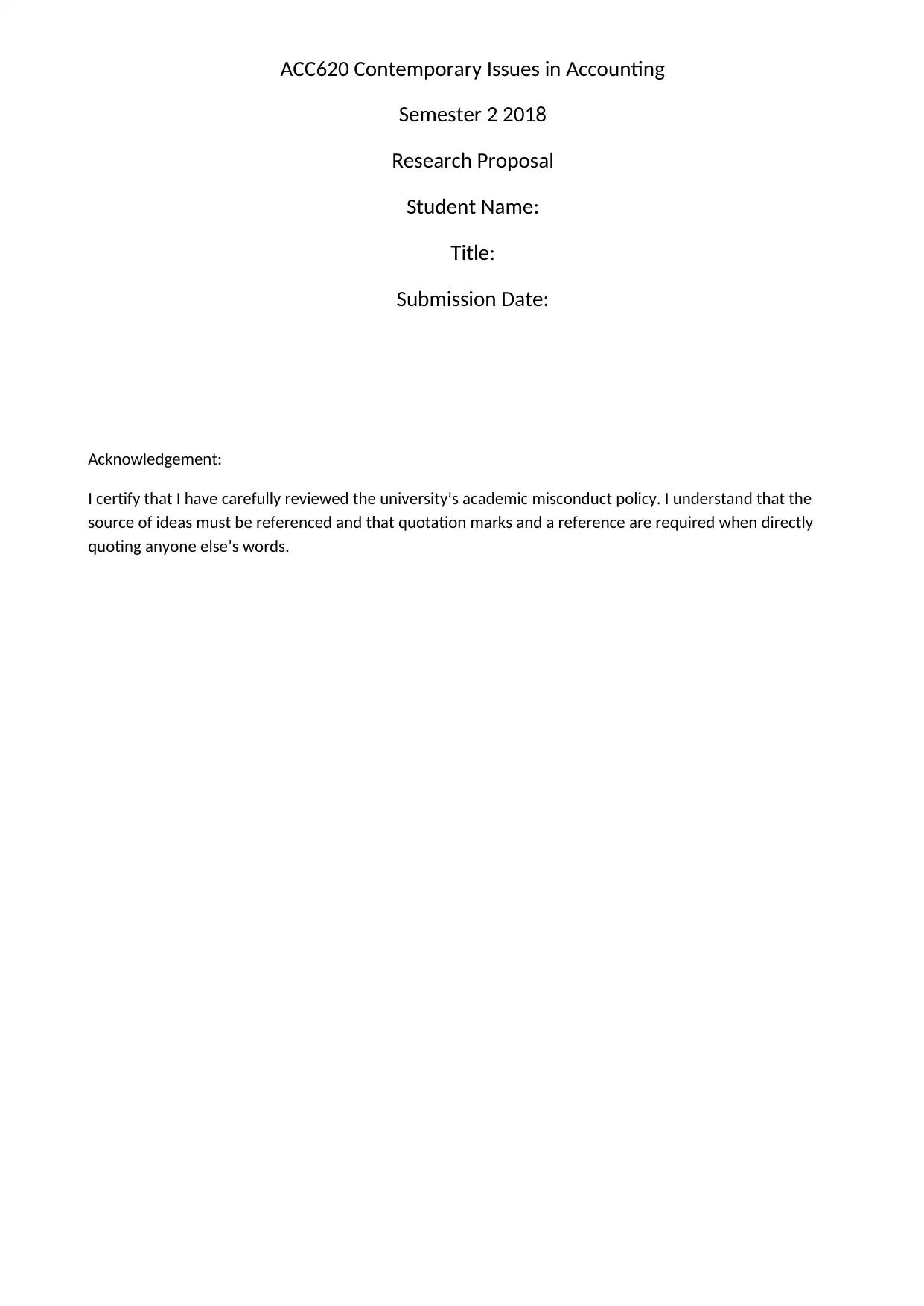
ACC620 Contemporary Issues in Accounting
Semester 2 2018
Research Proposal
Student Name:
Title:
Submission Date:
Acknowledgement:
I certify that I have carefully reviewed the university’s academic misconduct policy. I understand that the
source of ideas must be referenced and that quotation marks and a reference are required when directly
quoting anyone else’s words.
Semester 2 2018
Research Proposal
Student Name:
Title:
Submission Date:
Acknowledgement:
I certify that I have carefully reviewed the university’s academic misconduct policy. I understand that the
source of ideas must be referenced and that quotation marks and a reference are required when directly
quoting anyone else’s words.
Paraphrase This Document
Need a fresh take? Get an instant paraphrase of this document with our AI Paraphraser
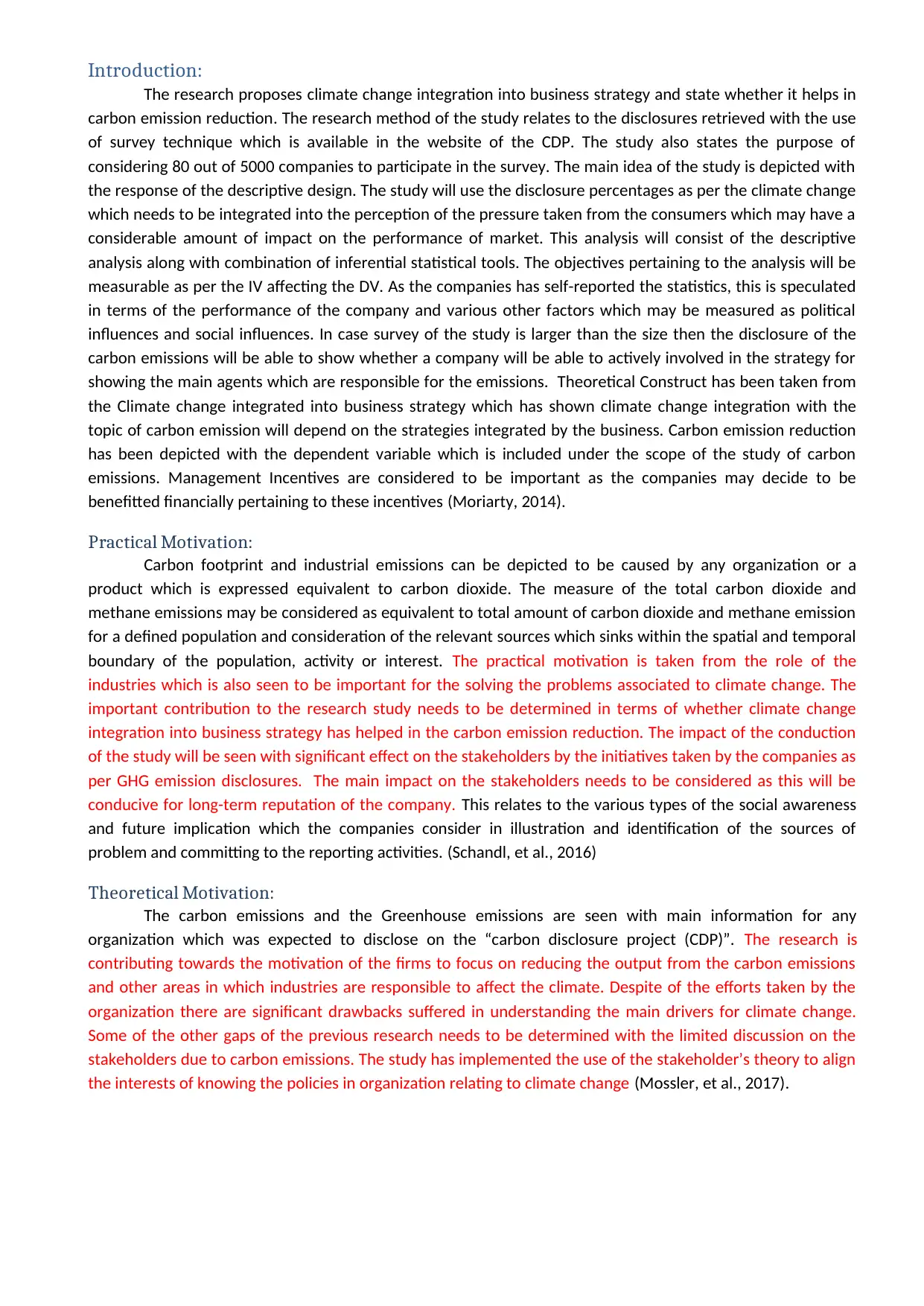
Introduction:
The research proposes climate change integration into business strategy and state whether it helps in
carbon emission reduction. The research method of the study relates to the disclosures retrieved with the use
of survey technique which is available in the website of the CDP. The study also states the purpose of
considering 80 out of 5000 companies to participate in the survey. The main idea of the study is depicted with
the response of the descriptive design. The study will use the disclosure percentages as per the climate change
which needs to be integrated into the perception of the pressure taken from the consumers which may have a
considerable amount of impact on the performance of market. This analysis will consist of the descriptive
analysis along with combination of inferential statistical tools. The objectives pertaining to the analysis will be
measurable as per the IV affecting the DV. As the companies has self-reported the statistics, this is speculated
in terms of the performance of the company and various other factors which may be measured as political
influences and social influences. In case survey of the study is larger than the size then the disclosure of the
carbon emissions will be able to show whether a company will be able to actively involved in the strategy for
showing the main agents which are responsible for the emissions. Theoretical Construct has been taken from
the Climate change integrated into business strategy which has shown climate change integration with the
topic of carbon emission will depend on the strategies integrated by the business. Carbon emission reduction
has been depicted with the dependent variable which is included under the scope of the study of carbon
emissions. Management Incentives are considered to be important as the companies may decide to be
benefitted financially pertaining to these incentives (Moriarty, 2014).
Practical Motivation:
Carbon footprint and industrial emissions can be depicted to be caused by any organization or a
product which is expressed equivalent to carbon dioxide. The measure of the total carbon dioxide and
methane emissions may be considered as equivalent to total amount of carbon dioxide and methane emission
for a defined population and consideration of the relevant sources which sinks within the spatial and temporal
boundary of the population, activity or interest. The practical motivation is taken from the role of the
industries which is also seen to be important for the solving the problems associated to climate change. The
important contribution to the research study needs to be determined in terms of whether climate change
integration into business strategy has helped in the carbon emission reduction. The impact of the conduction
of the study will be seen with significant effect on the stakeholders by the initiatives taken by the companies as
per GHG emission disclosures. The main impact on the stakeholders needs to be considered as this will be
conducive for long-term reputation of the company. This relates to the various types of the social awareness
and future implication which the companies consider in illustration and identification of the sources of
problem and committing to the reporting activities. (Schandl, et al., 2016)
Theoretical Motivation:
The carbon emissions and the Greenhouse emissions are seen with main information for any
organization which was expected to disclose on the “carbon disclosure project (CDP)”. The research is
contributing towards the motivation of the firms to focus on reducing the output from the carbon emissions
and other areas in which industries are responsible to affect the climate. Despite of the efforts taken by the
organization there are significant drawbacks suffered in understanding the main drivers for climate change.
Some of the other gaps of the previous research needs to be determined with the limited discussion on the
stakeholders due to carbon emissions. The study has implemented the use of the stakeholder’s theory to align
the interests of knowing the policies in organization relating to climate change (Mossler, et al., 2017).
The research proposes climate change integration into business strategy and state whether it helps in
carbon emission reduction. The research method of the study relates to the disclosures retrieved with the use
of survey technique which is available in the website of the CDP. The study also states the purpose of
considering 80 out of 5000 companies to participate in the survey. The main idea of the study is depicted with
the response of the descriptive design. The study will use the disclosure percentages as per the climate change
which needs to be integrated into the perception of the pressure taken from the consumers which may have a
considerable amount of impact on the performance of market. This analysis will consist of the descriptive
analysis along with combination of inferential statistical tools. The objectives pertaining to the analysis will be
measurable as per the IV affecting the DV. As the companies has self-reported the statistics, this is speculated
in terms of the performance of the company and various other factors which may be measured as political
influences and social influences. In case survey of the study is larger than the size then the disclosure of the
carbon emissions will be able to show whether a company will be able to actively involved in the strategy for
showing the main agents which are responsible for the emissions. Theoretical Construct has been taken from
the Climate change integrated into business strategy which has shown climate change integration with the
topic of carbon emission will depend on the strategies integrated by the business. Carbon emission reduction
has been depicted with the dependent variable which is included under the scope of the study of carbon
emissions. Management Incentives are considered to be important as the companies may decide to be
benefitted financially pertaining to these incentives (Moriarty, 2014).
Practical Motivation:
Carbon footprint and industrial emissions can be depicted to be caused by any organization or a
product which is expressed equivalent to carbon dioxide. The measure of the total carbon dioxide and
methane emissions may be considered as equivalent to total amount of carbon dioxide and methane emission
for a defined population and consideration of the relevant sources which sinks within the spatial and temporal
boundary of the population, activity or interest. The practical motivation is taken from the role of the
industries which is also seen to be important for the solving the problems associated to climate change. The
important contribution to the research study needs to be determined in terms of whether climate change
integration into business strategy has helped in the carbon emission reduction. The impact of the conduction
of the study will be seen with significant effect on the stakeholders by the initiatives taken by the companies as
per GHG emission disclosures. The main impact on the stakeholders needs to be considered as this will be
conducive for long-term reputation of the company. This relates to the various types of the social awareness
and future implication which the companies consider in illustration and identification of the sources of
problem and committing to the reporting activities. (Schandl, et al., 2016)
Theoretical Motivation:
The carbon emissions and the Greenhouse emissions are seen with main information for any
organization which was expected to disclose on the “carbon disclosure project (CDP)”. The research is
contributing towards the motivation of the firms to focus on reducing the output from the carbon emissions
and other areas in which industries are responsible to affect the climate. Despite of the efforts taken by the
organization there are significant drawbacks suffered in understanding the main drivers for climate change.
Some of the other gaps of the previous research needs to be determined with the limited discussion on the
stakeholders due to carbon emissions. The study has implemented the use of the stakeholder’s theory to align
the interests of knowing the policies in organization relating to climate change (Mossler, et al., 2017).
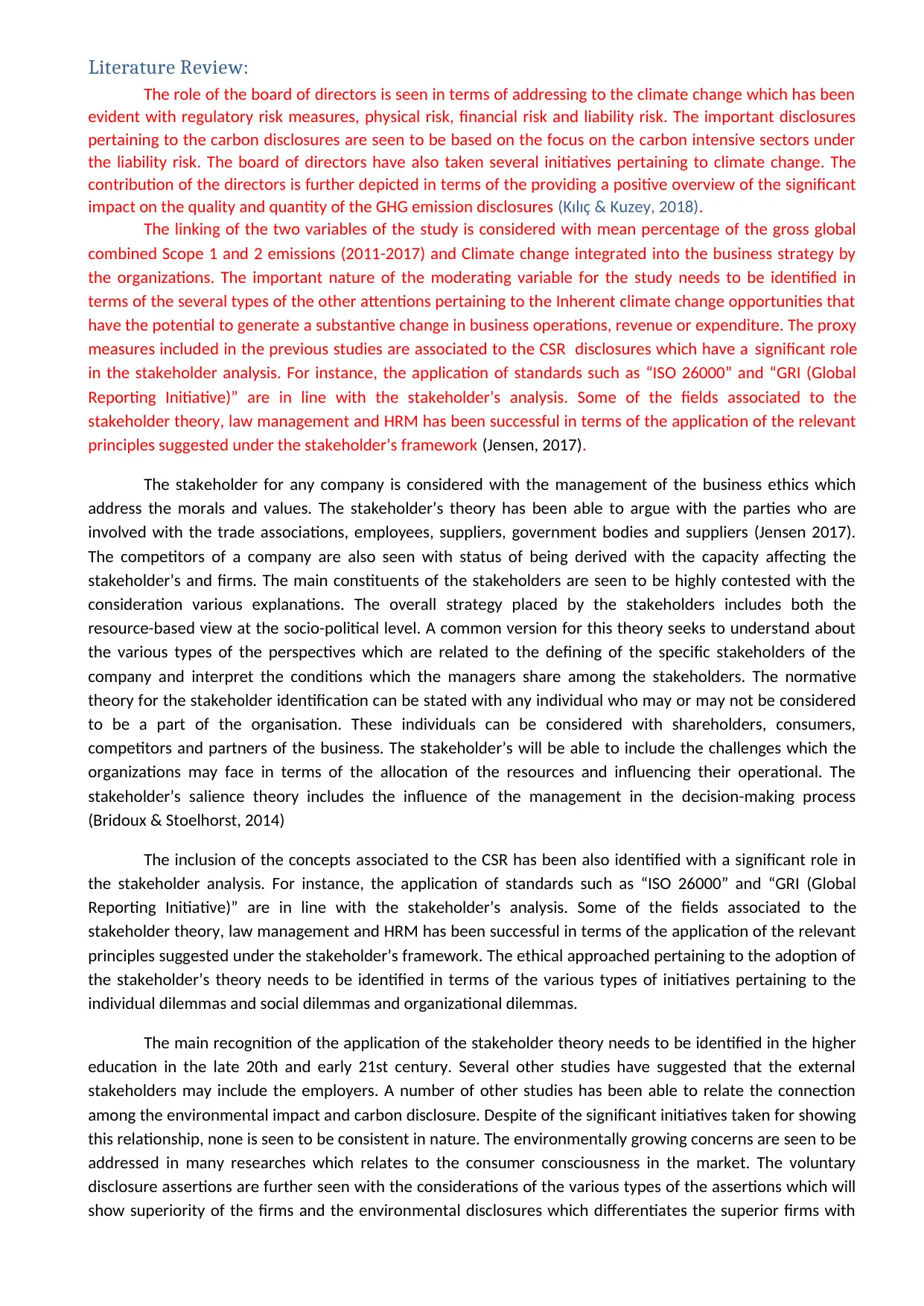
Literature Review:
The role of the board of directors is seen in terms of addressing to the climate change which has been
evident with regulatory risk measures, physical risk, financial risk and liability risk. The important disclosures
pertaining to the carbon disclosures are seen to be based on the focus on the carbon intensive sectors under
the liability risk. The board of directors have also taken several initiatives pertaining to climate change. The
contribution of the directors is further depicted in terms of the providing a positive overview of the significant
impact on the quality and quantity of the GHG emission disclosures (Kılıç & Kuzey, 2018).
The linking of the two variables of the study is considered with mean percentage of the gross global
combined Scope 1 and 2 emissions (2011-2017) and Climate change integrated into the business strategy by
the organizations. The important nature of the moderating variable for the study needs to be identified in
terms of the several types of the other attentions pertaining to the Inherent climate change opportunities that
have the potential to generate a substantive change in business operations, revenue or expenditure. The proxy
measures included in the previous studies are associated to the CSR disclosures which have a significant role
in the stakeholder analysis. For instance, the application of standards such as “ISO 26000” and “GRI (Global
Reporting Initiative)” are in line with the stakeholder’s analysis. Some of the fields associated to the
stakeholder theory, law management and HRM has been successful in terms of the application of the relevant
principles suggested under the stakeholder’s framework (Jensen, 2017).
The stakeholder for any company is considered with the management of the business ethics which
address the morals and values. The stakeholder’s theory has been able to argue with the parties who are
involved with the trade associations, employees, suppliers, government bodies and suppliers (Jensen 2017).
The competitors of a company are also seen with status of being derived with the capacity affecting the
stakeholder’s and firms. The main constituents of the stakeholders are seen to be highly contested with the
consideration various explanations. The overall strategy placed by the stakeholders includes both the
resource-based view at the socio-political level. A common version for this theory seeks to understand about
the various types of the perspectives which are related to the defining of the specific stakeholders of the
company and interpret the conditions which the managers share among the stakeholders. The normative
theory for the stakeholder identification can be stated with any individual who may or may not be considered
to be a part of the organisation. These individuals can be considered with shareholders, consumers,
competitors and partners of the business. The stakeholder’s will be able to include the challenges which the
organizations may face in terms of the allocation of the resources and influencing their operational. The
stakeholder’s salience theory includes the influence of the management in the decision-making process
(Bridoux & Stoelhorst, 2014)
The inclusion of the concepts associated to the CSR has been also identified with a significant role in
the stakeholder analysis. For instance, the application of standards such as “ISO 26000” and “GRI (Global
Reporting Initiative)” are in line with the stakeholder’s analysis. Some of the fields associated to the
stakeholder theory, law management and HRM has been successful in terms of the application of the relevant
principles suggested under the stakeholder’s framework. The ethical approached pertaining to the adoption of
the stakeholder’s theory needs to be identified in terms of the various types of initiatives pertaining to the
individual dilemmas and social dilemmas and organizational dilemmas.
The main recognition of the application of the stakeholder theory needs to be identified in the higher
education in the late 20th and early 21st century. Several other studies have suggested that the external
stakeholders may include the employers. A number of other studies has been able to relate the connection
among the environmental impact and carbon disclosure. Despite of the significant initiatives taken for showing
this relationship, none is seen to be consistent in nature. The environmentally growing concerns are seen to be
addressed in many researches which relates to the consumer consciousness in the market. The voluntary
disclosure assertions are further seen with the considerations of the various types of the assertions which will
show superiority of the firms and the environmental disclosures which differentiates the superior firms with
The role of the board of directors is seen in terms of addressing to the climate change which has been
evident with regulatory risk measures, physical risk, financial risk and liability risk. The important disclosures
pertaining to the carbon disclosures are seen to be based on the focus on the carbon intensive sectors under
the liability risk. The board of directors have also taken several initiatives pertaining to climate change. The
contribution of the directors is further depicted in terms of the providing a positive overview of the significant
impact on the quality and quantity of the GHG emission disclosures (Kılıç & Kuzey, 2018).
The linking of the two variables of the study is considered with mean percentage of the gross global
combined Scope 1 and 2 emissions (2011-2017) and Climate change integrated into the business strategy by
the organizations. The important nature of the moderating variable for the study needs to be identified in
terms of the several types of the other attentions pertaining to the Inherent climate change opportunities that
have the potential to generate a substantive change in business operations, revenue or expenditure. The proxy
measures included in the previous studies are associated to the CSR disclosures which have a significant role
in the stakeholder analysis. For instance, the application of standards such as “ISO 26000” and “GRI (Global
Reporting Initiative)” are in line with the stakeholder’s analysis. Some of the fields associated to the
stakeholder theory, law management and HRM has been successful in terms of the application of the relevant
principles suggested under the stakeholder’s framework (Jensen, 2017).
The stakeholder for any company is considered with the management of the business ethics which
address the morals and values. The stakeholder’s theory has been able to argue with the parties who are
involved with the trade associations, employees, suppliers, government bodies and suppliers (Jensen 2017).
The competitors of a company are also seen with status of being derived with the capacity affecting the
stakeholder’s and firms. The main constituents of the stakeholders are seen to be highly contested with the
consideration various explanations. The overall strategy placed by the stakeholders includes both the
resource-based view at the socio-political level. A common version for this theory seeks to understand about
the various types of the perspectives which are related to the defining of the specific stakeholders of the
company and interpret the conditions which the managers share among the stakeholders. The normative
theory for the stakeholder identification can be stated with any individual who may or may not be considered
to be a part of the organisation. These individuals can be considered with shareholders, consumers,
competitors and partners of the business. The stakeholder’s will be able to include the challenges which the
organizations may face in terms of the allocation of the resources and influencing their operational. The
stakeholder’s salience theory includes the influence of the management in the decision-making process
(Bridoux & Stoelhorst, 2014)
The inclusion of the concepts associated to the CSR has been also identified with a significant role in
the stakeholder analysis. For instance, the application of standards such as “ISO 26000” and “GRI (Global
Reporting Initiative)” are in line with the stakeholder’s analysis. Some of the fields associated to the
stakeholder theory, law management and HRM has been successful in terms of the application of the relevant
principles suggested under the stakeholder’s framework. The ethical approached pertaining to the adoption of
the stakeholder’s theory needs to be identified in terms of the various types of initiatives pertaining to the
individual dilemmas and social dilemmas and organizational dilemmas.
The main recognition of the application of the stakeholder theory needs to be identified in the higher
education in the late 20th and early 21st century. Several other studies have suggested that the external
stakeholders may include the employers. A number of other studies has been able to relate the connection
among the environmental impact and carbon disclosure. Despite of the significant initiatives taken for showing
this relationship, none is seen to be consistent in nature. The environmentally growing concerns are seen to be
addressed in many researches which relates to the consumer consciousness in the market. The voluntary
disclosure assertions are further seen with the considerations of the various types of the assertions which will
show superiority of the firms and the environmental disclosures which differentiates the superior firms with
⊘ This is a preview!⊘
Do you want full access?
Subscribe today to unlock all pages.

Trusted by 1+ million students worldwide
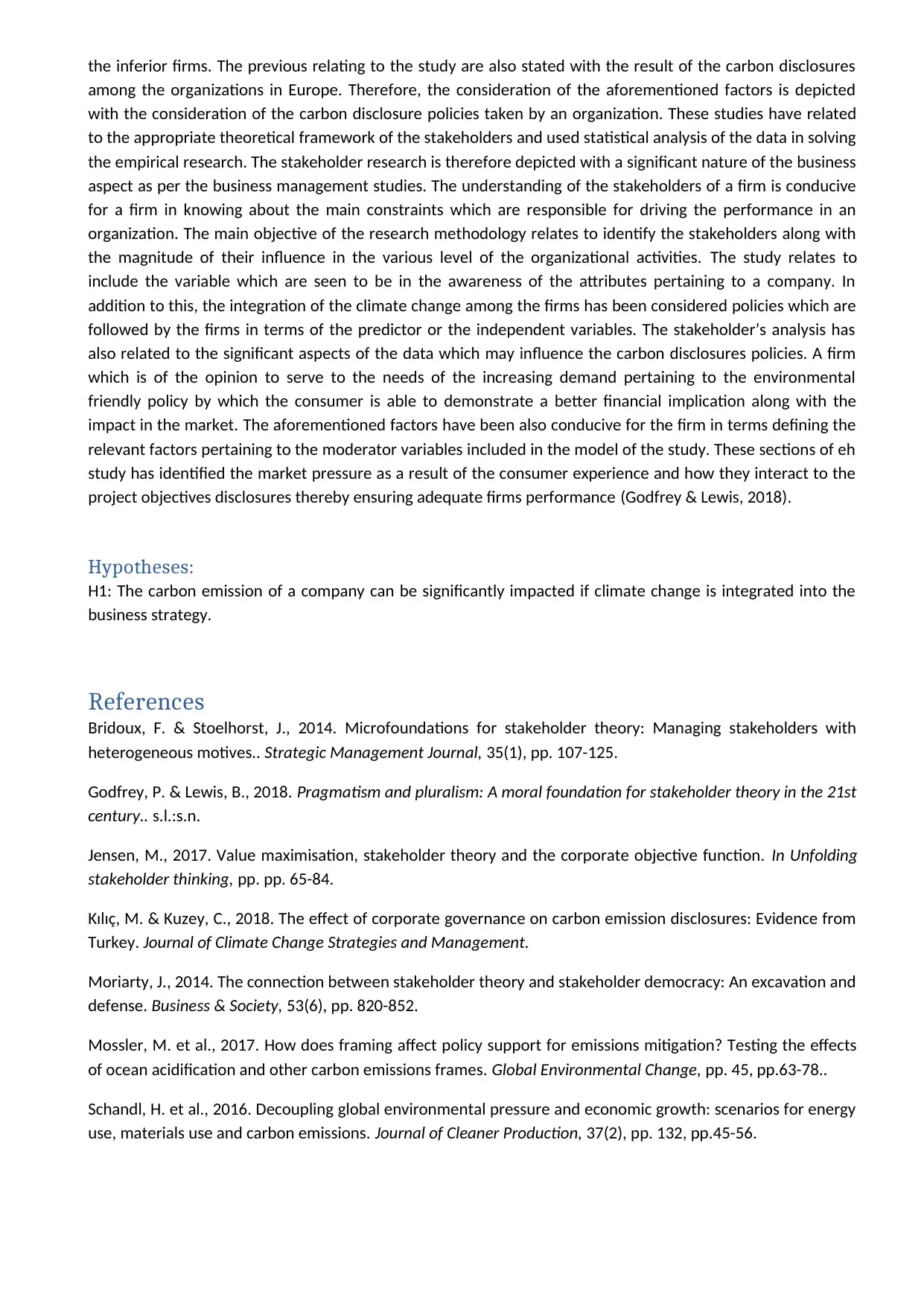
the inferior firms. The previous relating to the study are also stated with the result of the carbon disclosures
among the organizations in Europe. Therefore, the consideration of the aforementioned factors is depicted
with the consideration of the carbon disclosure policies taken by an organization. These studies have related
to the appropriate theoretical framework of the stakeholders and used statistical analysis of the data in solving
the empirical research. The stakeholder research is therefore depicted with a significant nature of the business
aspect as per the business management studies. The understanding of the stakeholders of a firm is conducive
for a firm in knowing about the main constraints which are responsible for driving the performance in an
organization. The main objective of the research methodology relates to identify the stakeholders along with
the magnitude of their influence in the various level of the organizational activities. The study relates to
include the variable which are seen to be in the awareness of the attributes pertaining to a company. In
addition to this, the integration of the climate change among the firms has been considered policies which are
followed by the firms in terms of the predictor or the independent variables. The stakeholder’s analysis has
also related to the significant aspects of the data which may influence the carbon disclosures policies. A firm
which is of the opinion to serve to the needs of the increasing demand pertaining to the environmental
friendly policy by which the consumer is able to demonstrate a better financial implication along with the
impact in the market. The aforementioned factors have been also conducive for the firm in terms defining the
relevant factors pertaining to the moderator variables included in the model of the study. These sections of eh
study has identified the market pressure as a result of the consumer experience and how they interact to the
project objectives disclosures thereby ensuring adequate firms performance (Godfrey & Lewis, 2018).
Hypotheses:
H1: The carbon emission of a company can be significantly impacted if climate change is integrated into the
business strategy.
References
Bridoux, F. & Stoelhorst, J., 2014. Microfoundations for stakeholder theory: Managing stakeholders with
heterogeneous motives.. Strategic Management Journal, 35(1), pp. 107-125.
Godfrey, P. & Lewis, B., 2018. Pragmatism and pluralism: A moral foundation for stakeholder theory in the 21st
century.. s.l.:s.n.
Jensen, M., 2017. Value maximisation, stakeholder theory and the corporate objective function. In Unfolding
stakeholder thinking, pp. pp. 65-84.
Kılıç, M. & Kuzey, C., 2018. The effect of corporate governance on carbon emission disclosures: Evidence from
Turkey. Journal of Climate Change Strategies and Management.
Moriarty, J., 2014. The connection between stakeholder theory and stakeholder democracy: An excavation and
defense. Business & Society, 53(6), pp. 820-852.
Mossler, M. et al., 2017. How does framing affect policy support for emissions mitigation? Testing the effects
of ocean acidification and other carbon emissions frames. Global Environmental Change, pp. 45, pp.63-78..
Schandl, H. et al., 2016. Decoupling global environmental pressure and economic growth: scenarios for energy
use, materials use and carbon emissions. Journal of Cleaner Production, 37(2), pp. 132, pp.45-56.
among the organizations in Europe. Therefore, the consideration of the aforementioned factors is depicted
with the consideration of the carbon disclosure policies taken by an organization. These studies have related
to the appropriate theoretical framework of the stakeholders and used statistical analysis of the data in solving
the empirical research. The stakeholder research is therefore depicted with a significant nature of the business
aspect as per the business management studies. The understanding of the stakeholders of a firm is conducive
for a firm in knowing about the main constraints which are responsible for driving the performance in an
organization. The main objective of the research methodology relates to identify the stakeholders along with
the magnitude of their influence in the various level of the organizational activities. The study relates to
include the variable which are seen to be in the awareness of the attributes pertaining to a company. In
addition to this, the integration of the climate change among the firms has been considered policies which are
followed by the firms in terms of the predictor or the independent variables. The stakeholder’s analysis has
also related to the significant aspects of the data which may influence the carbon disclosures policies. A firm
which is of the opinion to serve to the needs of the increasing demand pertaining to the environmental
friendly policy by which the consumer is able to demonstrate a better financial implication along with the
impact in the market. The aforementioned factors have been also conducive for the firm in terms defining the
relevant factors pertaining to the moderator variables included in the model of the study. These sections of eh
study has identified the market pressure as a result of the consumer experience and how they interact to the
project objectives disclosures thereby ensuring adequate firms performance (Godfrey & Lewis, 2018).
Hypotheses:
H1: The carbon emission of a company can be significantly impacted if climate change is integrated into the
business strategy.
References
Bridoux, F. & Stoelhorst, J., 2014. Microfoundations for stakeholder theory: Managing stakeholders with
heterogeneous motives.. Strategic Management Journal, 35(1), pp. 107-125.
Godfrey, P. & Lewis, B., 2018. Pragmatism and pluralism: A moral foundation for stakeholder theory in the 21st
century.. s.l.:s.n.
Jensen, M., 2017. Value maximisation, stakeholder theory and the corporate objective function. In Unfolding
stakeholder thinking, pp. pp. 65-84.
Kılıç, M. & Kuzey, C., 2018. The effect of corporate governance on carbon emission disclosures: Evidence from
Turkey. Journal of Climate Change Strategies and Management.
Moriarty, J., 2014. The connection between stakeholder theory and stakeholder democracy: An excavation and
defense. Business & Society, 53(6), pp. 820-852.
Mossler, M. et al., 2017. How does framing affect policy support for emissions mitigation? Testing the effects
of ocean acidification and other carbon emissions frames. Global Environmental Change, pp. 45, pp.63-78..
Schandl, H. et al., 2016. Decoupling global environmental pressure and economic growth: scenarios for energy
use, materials use and carbon emissions. Journal of Cleaner Production, 37(2), pp. 132, pp.45-56.
Paraphrase This Document
Need a fresh take? Get an instant paraphrase of this document with our AI Paraphraser
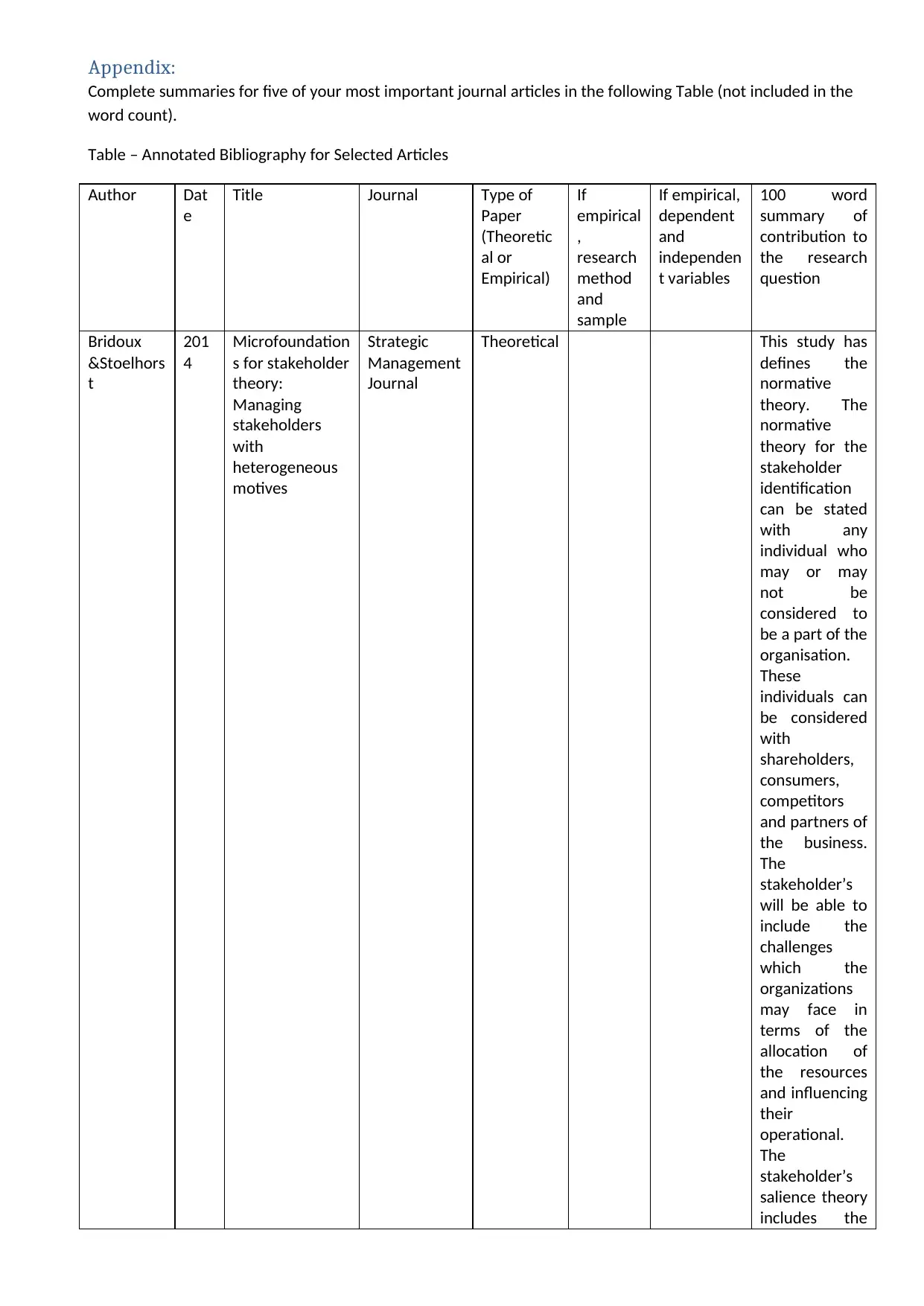
Appendix:
Complete summaries for five of your most important journal articles in the following Table (not included in the
word count).
Table – Annotated Bibliography for Selected Articles
Author Dat
e
Title Journal Type of
Paper
(Theoretic
al or
Empirical)
If
empirical
,
research
method
and
sample
If empirical,
dependent
and
independen
t variables
100 word
summary of
contribution to
the research
question
Bridoux
&Stoelhors
t
201
4
Microfoundation
s for stakeholder
theory:
Managing
stakeholders
with
heterogeneous
motives
Strategic
Management
Journal
Theoretical This study has
defines the
normative
theory. The
normative
theory for the
stakeholder
identification
can be stated
with any
individual who
may or may
not be
considered to
be a part of the
organisation.
These
individuals can
be considered
with
shareholders,
consumers,
competitors
and partners of
the business.
The
stakeholder’s
will be able to
include the
challenges
which the
organizations
may face in
terms of the
allocation of
the resources
and influencing
their
operational.
The
stakeholder’s
salience theory
includes the
Complete summaries for five of your most important journal articles in the following Table (not included in the
word count).
Table – Annotated Bibliography for Selected Articles
Author Dat
e
Title Journal Type of
Paper
(Theoretic
al or
Empirical)
If
empirical
,
research
method
and
sample
If empirical,
dependent
and
independen
t variables
100 word
summary of
contribution to
the research
question
Bridoux
&Stoelhors
t
201
4
Microfoundation
s for stakeholder
theory:
Managing
stakeholders
with
heterogeneous
motives
Strategic
Management
Journal
Theoretical This study has
defines the
normative
theory. The
normative
theory for the
stakeholder
identification
can be stated
with any
individual who
may or may
not be
considered to
be a part of the
organisation.
These
individuals can
be considered
with
shareholders,
consumers,
competitors
and partners of
the business.
The
stakeholder’s
will be able to
include the
challenges
which the
organizations
may face in
terms of the
allocation of
the resources
and influencing
their
operational.
The
stakeholder’s
salience theory
includes the
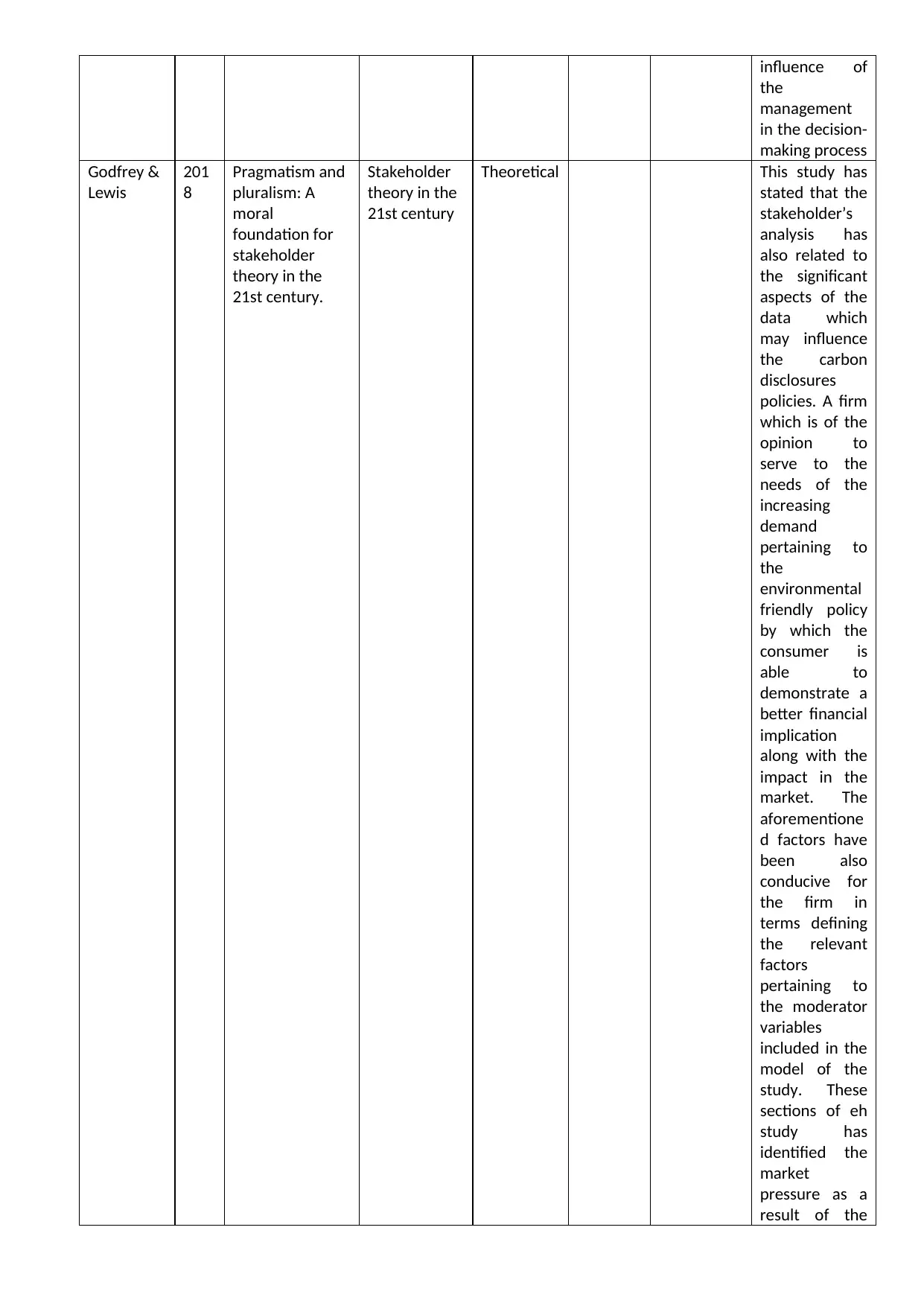
influence of
the
management
in the decision-
making process
Godfrey &
Lewis
201
8
Pragmatism and
pluralism: A
moral
foundation for
stakeholder
theory in the
21st century.
Stakeholder
theory in the
21st century
Theoretical This study has
stated that the
stakeholder’s
analysis has
also related to
the significant
aspects of the
data which
may influence
the carbon
disclosures
policies. A firm
which is of the
opinion to
serve to the
needs of the
increasing
demand
pertaining to
the
environmental
friendly policy
by which the
consumer is
able to
demonstrate a
better financial
implication
along with the
impact in the
market. The
aforementione
d factors have
been also
conducive for
the firm in
terms defining
the relevant
factors
pertaining to
the moderator
variables
included in the
model of the
study. These
sections of eh
study has
identified the
market
pressure as a
result of the
the
management
in the decision-
making process
Godfrey &
Lewis
201
8
Pragmatism and
pluralism: A
moral
foundation for
stakeholder
theory in the
21st century.
Stakeholder
theory in the
21st century
Theoretical This study has
stated that the
stakeholder’s
analysis has
also related to
the significant
aspects of the
data which
may influence
the carbon
disclosures
policies. A firm
which is of the
opinion to
serve to the
needs of the
increasing
demand
pertaining to
the
environmental
friendly policy
by which the
consumer is
able to
demonstrate a
better financial
implication
along with the
impact in the
market. The
aforementione
d factors have
been also
conducive for
the firm in
terms defining
the relevant
factors
pertaining to
the moderator
variables
included in the
model of the
study. These
sections of eh
study has
identified the
market
pressure as a
result of the
⊘ This is a preview!⊘
Do you want full access?
Subscribe today to unlock all pages.

Trusted by 1+ million students worldwide
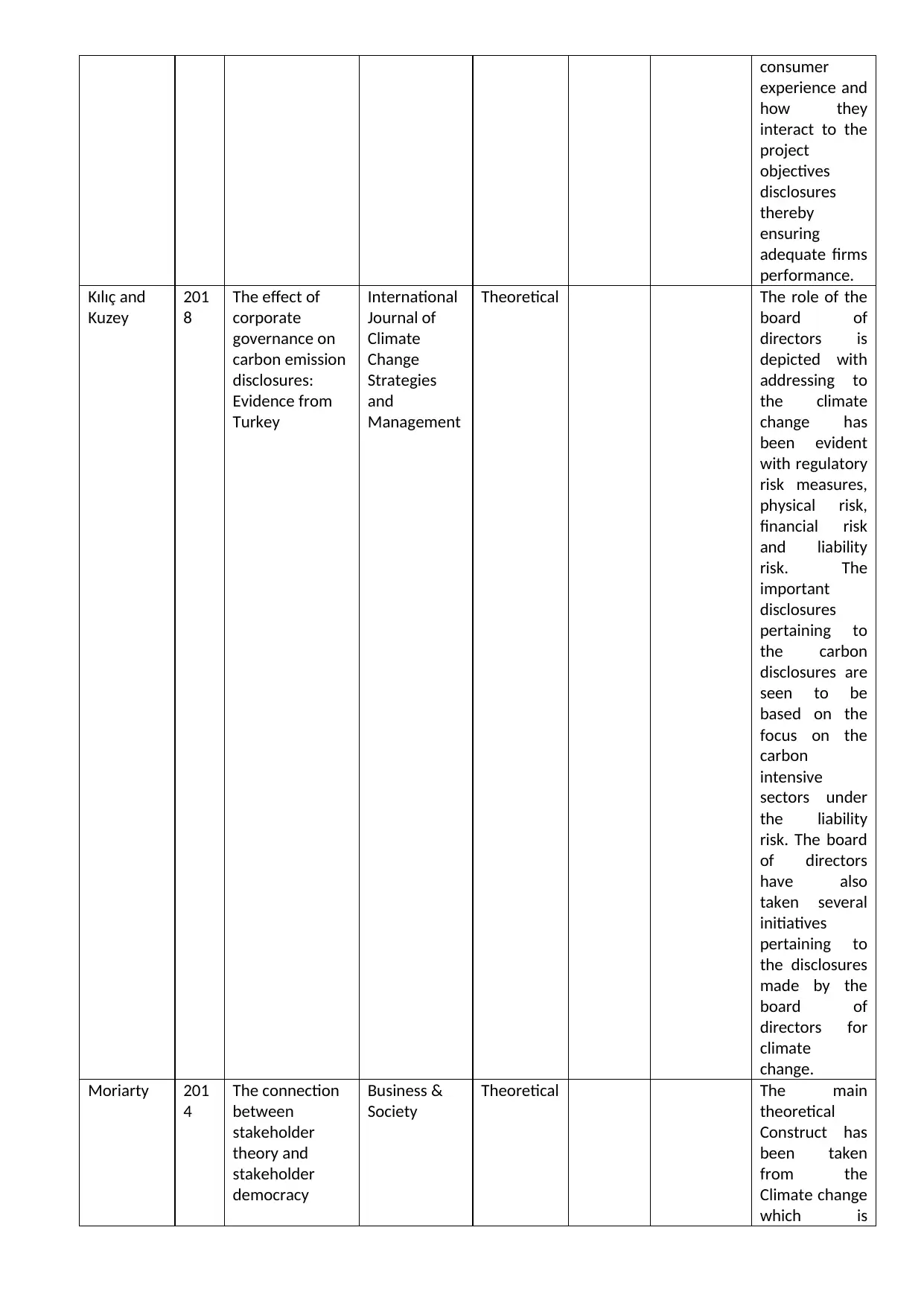
consumer
experience and
how they
interact to the
project
objectives
disclosures
thereby
ensuring
adequate firms
performance.
Kılıç and
Kuzey
201
8
The effect of
corporate
governance on
carbon emission
disclosures:
Evidence from
Turkey
International
Journal of
Climate
Change
Strategies
and
Management
Theoretical The role of the
board of
directors is
depicted with
addressing to
the climate
change has
been evident
with regulatory
risk measures,
physical risk,
financial risk
and liability
risk. The
important
disclosures
pertaining to
the carbon
disclosures are
seen to be
based on the
focus on the
carbon
intensive
sectors under
the liability
risk. The board
of directors
have also
taken several
initiatives
pertaining to
the disclosures
made by the
board of
directors for
climate
change.
Moriarty 201
4
The connection
between
stakeholder
theory and
stakeholder
democracy
Business &
Society
Theoretical The main
theoretical
Construct has
been taken
from the
Climate change
which is
experience and
how they
interact to the
project
objectives
disclosures
thereby
ensuring
adequate firms
performance.
Kılıç and
Kuzey
201
8
The effect of
corporate
governance on
carbon emission
disclosures:
Evidence from
Turkey
International
Journal of
Climate
Change
Strategies
and
Management
Theoretical The role of the
board of
directors is
depicted with
addressing to
the climate
change has
been evident
with regulatory
risk measures,
physical risk,
financial risk
and liability
risk. The
important
disclosures
pertaining to
the carbon
disclosures are
seen to be
based on the
focus on the
carbon
intensive
sectors under
the liability
risk. The board
of directors
have also
taken several
initiatives
pertaining to
the disclosures
made by the
board of
directors for
climate
change.
Moriarty 201
4
The connection
between
stakeholder
theory and
stakeholder
democracy
Business &
Society
Theoretical The main
theoretical
Construct has
been taken
from the
Climate change
which is
Paraphrase This Document
Need a fresh take? Get an instant paraphrase of this document with our AI Paraphraser
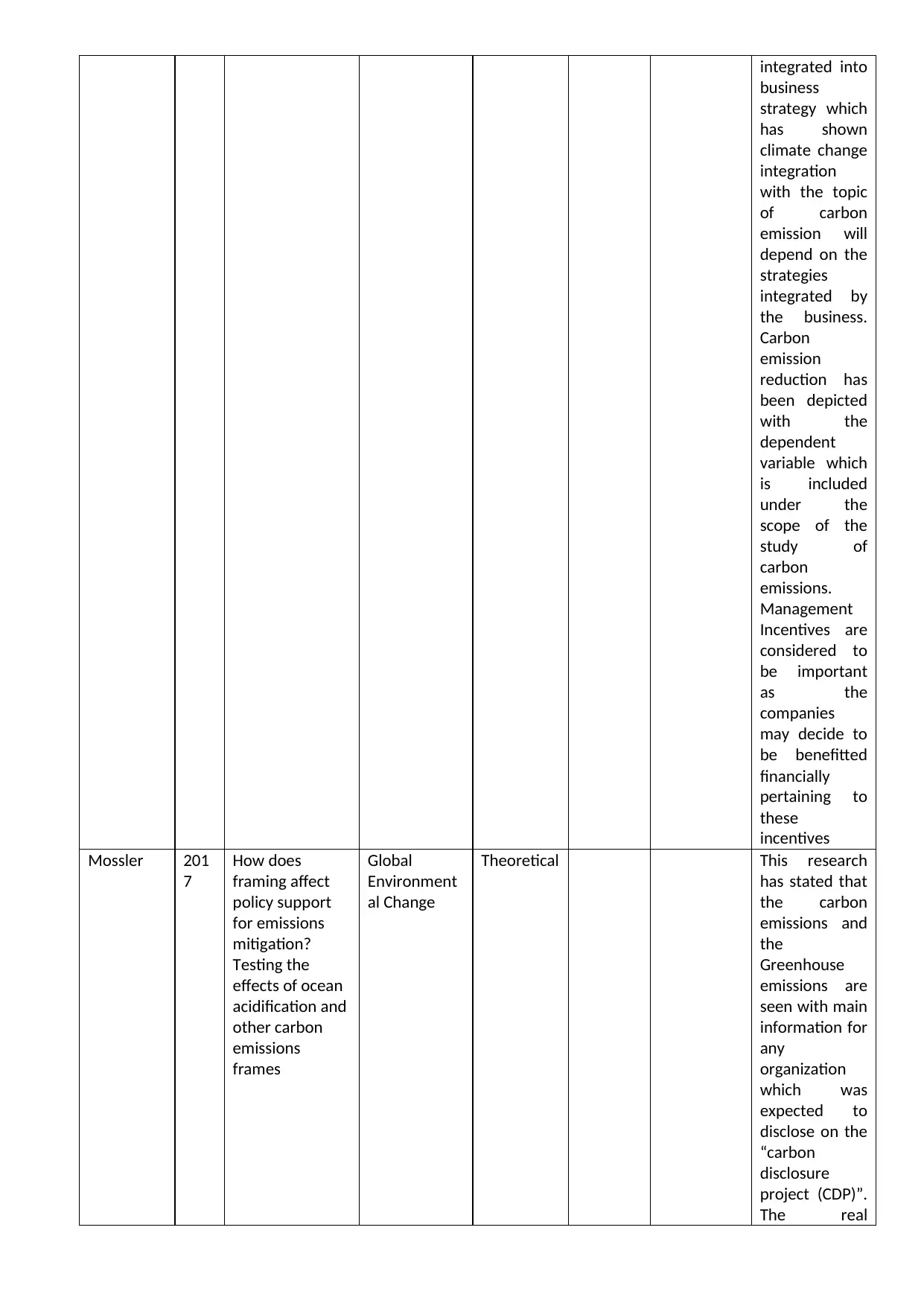
integrated into
business
strategy which
has shown
climate change
integration
with the topic
of carbon
emission will
depend on the
strategies
integrated by
the business.
Carbon
emission
reduction has
been depicted
with the
dependent
variable which
is included
under the
scope of the
study of
carbon
emissions.
Management
Incentives are
considered to
be important
as the
companies
may decide to
be benefitted
financially
pertaining to
these
incentives
Mossler 201
7
How does
framing affect
policy support
for emissions
mitigation?
Testing the
effects of ocean
acidification and
other carbon
emissions
frames
Global
Environment
al Change
Theoretical This research
has stated that
the carbon
emissions and
the
Greenhouse
emissions are
seen with main
information for
any
organization
which was
expected to
disclose on the
“carbon
disclosure
project (CDP)”.
The real
business
strategy which
has shown
climate change
integration
with the topic
of carbon
emission will
depend on the
strategies
integrated by
the business.
Carbon
emission
reduction has
been depicted
with the
dependent
variable which
is included
under the
scope of the
study of
carbon
emissions.
Management
Incentives are
considered to
be important
as the
companies
may decide to
be benefitted
financially
pertaining to
these
incentives
Mossler 201
7
How does
framing affect
policy support
for emissions
mitigation?
Testing the
effects of ocean
acidification and
other carbon
emissions
frames
Global
Environment
al Change
Theoretical This research
has stated that
the carbon
emissions and
the
Greenhouse
emissions are
seen with main
information for
any
organization
which was
expected to
disclose on the
“carbon
disclosure
project (CDP)”.
The real
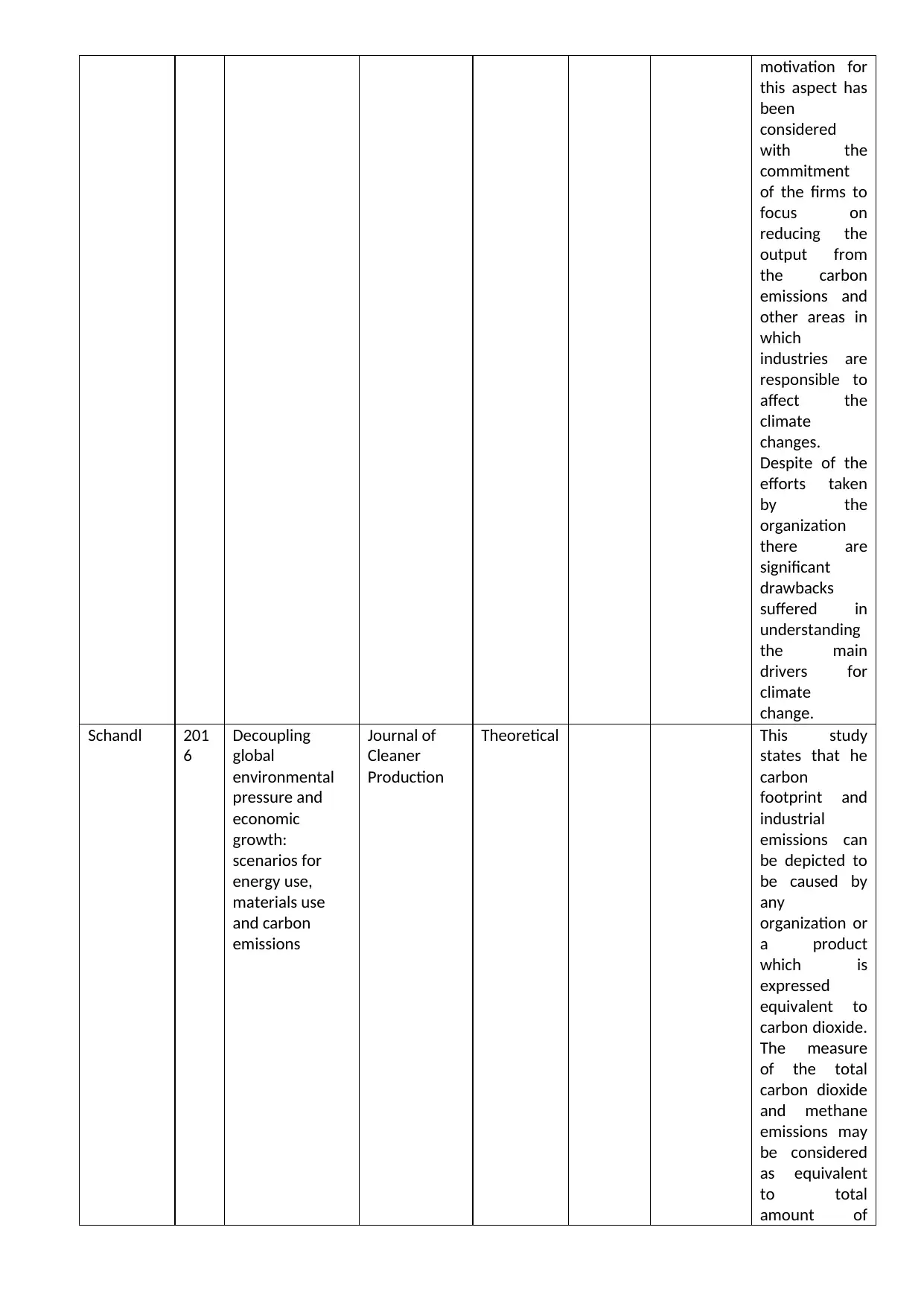
motivation for
this aspect has
been
considered
with the
commitment
of the firms to
focus on
reducing the
output from
the carbon
emissions and
other areas in
which
industries are
responsible to
affect the
climate
changes.
Despite of the
efforts taken
by the
organization
there are
significant
drawbacks
suffered in
understanding
the main
drivers for
climate
change.
Schandl 201
6
Decoupling
global
environmental
pressure and
economic
growth:
scenarios for
energy use,
materials use
and carbon
emissions
Journal of
Cleaner
Production
Theoretical This study
states that he
carbon
footprint and
industrial
emissions can
be depicted to
be caused by
any
organization or
a product
which is
expressed
equivalent to
carbon dioxide.
The measure
of the total
carbon dioxide
and methane
emissions may
be considered
as equivalent
to total
amount of
this aspect has
been
considered
with the
commitment
of the firms to
focus on
reducing the
output from
the carbon
emissions and
other areas in
which
industries are
responsible to
affect the
climate
changes.
Despite of the
efforts taken
by the
organization
there are
significant
drawbacks
suffered in
understanding
the main
drivers for
climate
change.
Schandl 201
6
Decoupling
global
environmental
pressure and
economic
growth:
scenarios for
energy use,
materials use
and carbon
emissions
Journal of
Cleaner
Production
Theoretical This study
states that he
carbon
footprint and
industrial
emissions can
be depicted to
be caused by
any
organization or
a product
which is
expressed
equivalent to
carbon dioxide.
The measure
of the total
carbon dioxide
and methane
emissions may
be considered
as equivalent
to total
amount of
⊘ This is a preview!⊘
Do you want full access?
Subscribe today to unlock all pages.

Trusted by 1+ million students worldwide
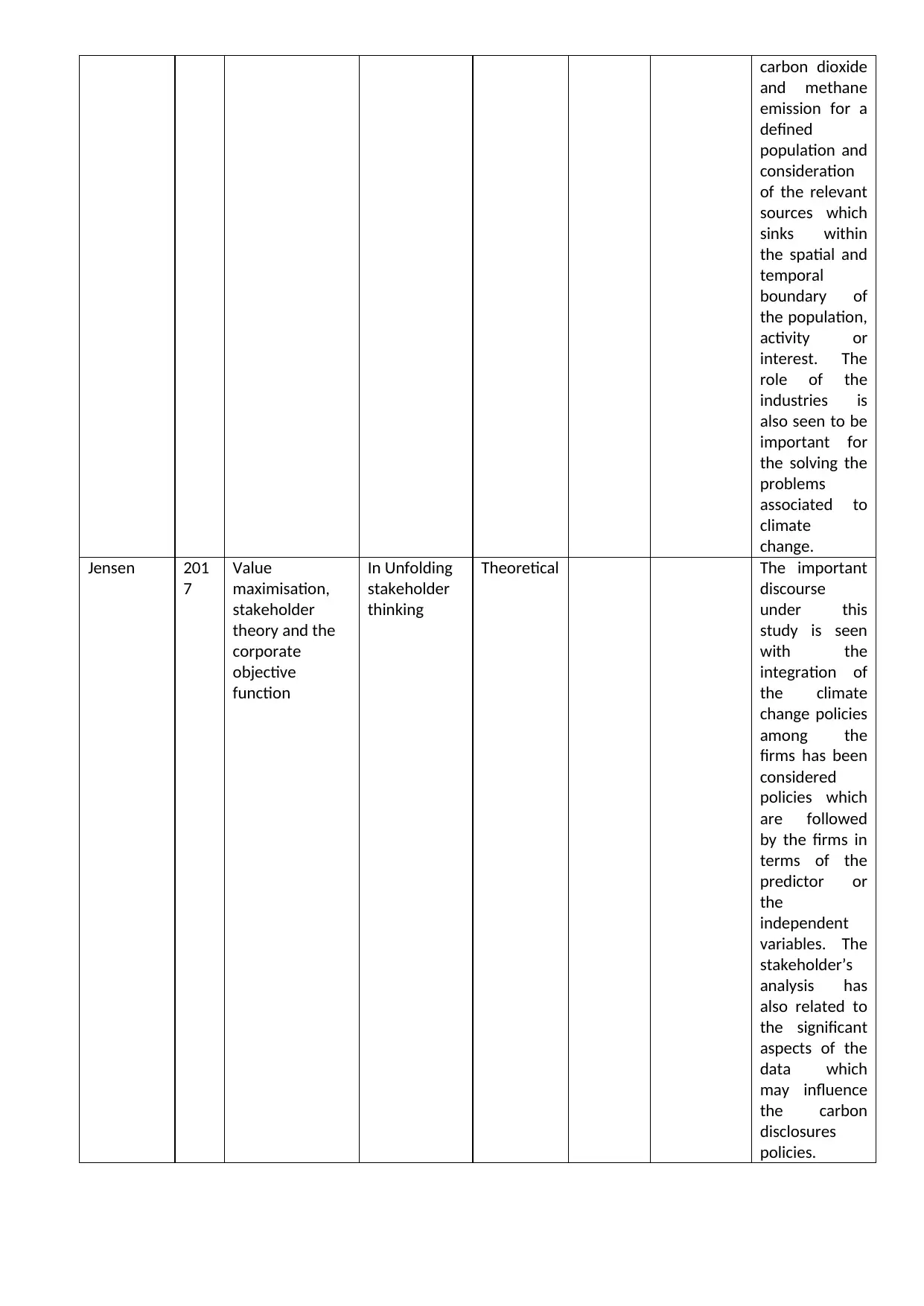
carbon dioxide
and methane
emission for a
defined
population and
consideration
of the relevant
sources which
sinks within
the spatial and
temporal
boundary of
the population,
activity or
interest. The
role of the
industries is
also seen to be
important for
the solving the
problems
associated to
climate
change.
Jensen 201
7
Value
maximisation,
stakeholder
theory and the
corporate
objective
function
In Unfolding
stakeholder
thinking
Theoretical The important
discourse
under this
study is seen
with the
integration of
the climate
change policies
among the
firms has been
considered
policies which
are followed
by the firms in
terms of the
predictor or
the
independent
variables. The
stakeholder’s
analysis has
also related to
the significant
aspects of the
data which
may influence
the carbon
disclosures
policies.
and methane
emission for a
defined
population and
consideration
of the relevant
sources which
sinks within
the spatial and
temporal
boundary of
the population,
activity or
interest. The
role of the
industries is
also seen to be
important for
the solving the
problems
associated to
climate
change.
Jensen 201
7
Value
maximisation,
stakeholder
theory and the
corporate
objective
function
In Unfolding
stakeholder
thinking
Theoretical The important
discourse
under this
study is seen
with the
integration of
the climate
change policies
among the
firms has been
considered
policies which
are followed
by the firms in
terms of the
predictor or
the
independent
variables. The
stakeholder’s
analysis has
also related to
the significant
aspects of the
data which
may influence
the carbon
disclosures
policies.
1 out of 10
Related Documents
Your All-in-One AI-Powered Toolkit for Academic Success.
+13062052269
info@desklib.com
Available 24*7 on WhatsApp / Email
![[object Object]](/_next/static/media/star-bottom.7253800d.svg)
Unlock your academic potential
Copyright © 2020–2025 A2Z Services. All Rights Reserved. Developed and managed by ZUCOL.





